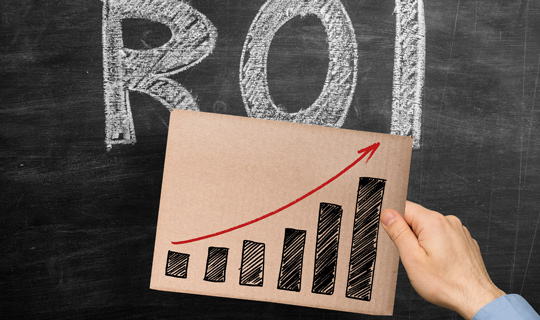
How Vendor Managed Inventory (VMI) Strengthens Supply Chain Resilience and Collaboration
To optimize inventory management, retailers and suppliers are increasingly turning to Vendor Managed Inventory (VMI) tools that transfer the responsibility…
Generix Ushers in a New Era of Intelligent Commerce for Retailers with AI-Driven Innovation Read the press release

To calculate the ROI of your WMS, you must first understand the costs associated with its implementation. These costs can be broken down into two categories: direct costs and indirect costs.
Direct costs include software and license costs, hardware and infrastructure costs, and implementation and training costs. These costs are typically the most straightforward to identify and include expenses such as the cost of purchasing and installing hardware and software, training employees, and any consulting fees associated with the implementation of your WMS.
Indirect costs are those that are less obvious and harder to quantify. These include labor costs, opportunity costs, and maintenance costs. Labor costs refer to the time and resources required to operate and maintain your WMS, while opportunity costs are the costs associated with opportunities that are missed due to the implementation of your WMS. Maintenance costs refer to the costs associated with keeping your WMS up to date and running smoothly.
In addition to understanding the costs associated with your WMS, you must also identify the potential benefits. These benefits can include increased efficiency, improved accuracy and inventory control, enhanced customer satisfaction, and streamlined processes.
One of the primary benefits of a WMS is increased efficiency. By automating many of the processes involved in managing a warehouse, a WMS can help reduce the amount of time and resources required to complete tasks, resulting in increased efficiency.
A WMS can also help improve accuracy and inventory control. With real-time visibility into inventory levels and location, warehouse managers can make informed decisions about what needs to be restocked and when, reducing the risk of stock shortages and overstocking.
Improved accuracy and inventory control can also result in enhanced customer satisfaction. By providing customers with the products they need when they need them, a WMS can help build trust and loyalty, leading to increased customer satisfaction.
Finally, a WMS can help streamline processes, reducing the number of steps required to complete tasks and improving the overall flow of the warehouse.
With an understanding of the costs and benefits associated with your WMS, it’s time to calculate the ROI. To do this, you’ll need to estimate the costs and benefits and choose a method for calculating the ROI.
To calculate the ROI of your WMS, you must first estimate the costs and benefits. This includes identifying all the costs associated with the implementation of your WMS, as well as the potential benefits. To ensure that your estimates are as accurate as possible, it’s important to gather data and consult with experts where necessary.
Once you’ve estimated the costs and benefits of your WMS, you’ll need to choose a method for calculating the ROI. There are three methods commonly used: the Simple ROI Calculation, the Net Present Value (NPV), and the Internal Rate of Return (IRR).
The Simple ROI Calculation is the most straightforward method and is used to determine the percentage return on investment. To calculate the Simple ROI, you divide the net benefits (the benefits minus the costs) by the costs and multiply by 100 to get the ROI as a percentage.
The Net Present Value (NPV) method takes into account the time value of money and calculates the present value of the future benefits and costs associated with your WMS investment. This method is useful when the benefits and costs of the investment will be received or incurred over a period of time.
The Internal Rate of Return (IRR) method is similar to the NPV method and takes into account the time value of money. However, instead of calculating the present value of the future benefits and costs, the IRR method calculates the interest rate at which the net present value of the investment is equal to zero.
Once you’ve chosen a method for calculating the ROI of your WMS, it’s time to apply it. To do this, you’ll need to input the estimated costs and benefits into your chosen method and calculate the ROI.
The ROI outcome will be a positive or negative number that represents the return on investment. If the ROI is positive, this means that the benefits of the WMS investment outweigh the costs. If the ROI is negative, this means that the costs of the WMS investment outweigh the benefits.
It’s important to evaluate the reliability of the ROI calculation to ensure that the results are accurate. This includes checking the assumptions used in the calculation and making sure that all relevant costs and benefits have been included.
Calculating the ROI of your WMS is a critical step in determining the success of your investment. By understanding the costs and benefits of your WMS and choosing a method for calculating the ROI, you can make informed decisions about your WMS investment and ensure that it provides the returns you expect.
This guide provides a step-by-step approach to calculating the ROI of your WMS, helping you make informed decisions about your investment. Whether you’re just starting out or have been using a WMS for years, this guide is an essential resource for anyone looking to maximize the returns from their WMS investment.

To optimize inventory management, retailers and suppliers are increasingly turning to Vendor Managed Inventory (VMI) tools that transfer the responsibility…

In an ever-evolving logistics environment, agile and precise warehouse resource management is essential to remain competitive. With increasing volumes driven…

France’s electronic invoicing reform relies on a Y-architecture, where Partner Dematerialization Providers (PDPs) play a central role in issuing and…

Work with our team to build your ideal supply chain software stack and tailor it to your unique business needs.